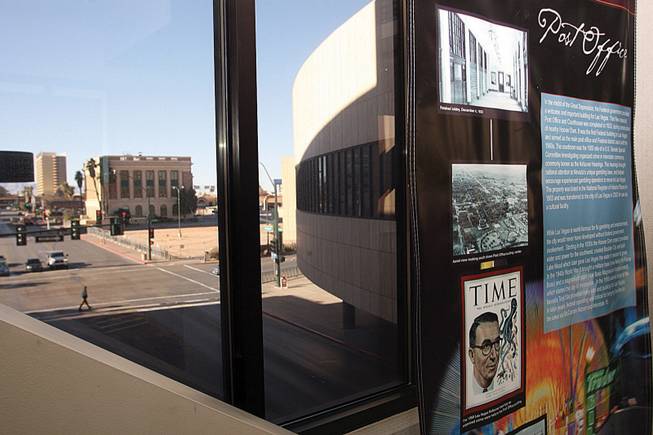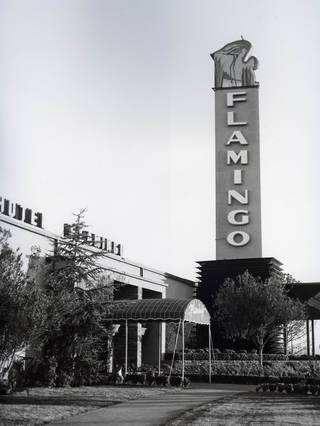
A poster in a pedestrian walkway at Las Vegas City Hall chronicles the history of the old post office and federal courthouse building, left, the proposed site of the Las Vegas Museum of Organized Crime and Law Enforcement, commonly called the “mob museum.”
Published Tuesday, June 16, 2009 | 2:27 p.m.
Updated Tuesday, June 16, 2009 | 6:45 p.m.
Sun coverage
Sun Archives
- City sells $85 million in bonds to finance downtown projects (3-18-2009)
- Commission doesn’t like city’s special district plan (3-13-2009)
- Council OKs up to $100 million in redevelopment bonds (3-4-2009)
- Mob museum walks on public tightrope (2-3-09)
- Several cities seek stimulus money for museums (2-3-09)
- City sewer fund has $148 million — a good place to steal money for a mob museum (1-28-2009)
- $80 million bet on development is risky (1-28-2009)
The Nevada Tourism Commission today approved a resolution in support of sales taxes that back bonds to develop a plaza around downtown Las Vegas’ mob museum.
The resolution next goes to Gov. Jim Gibbons for final state approval. If the governor concurs with the Tourism Commission’s assessment, the matter would be referred back to the Las Vegas City Council for an ordinance establishing the tourism district. Once that is completed, the city would develop an agreement with the state Department of Taxation for the diversion of tax proceeds with terms that can’t exceed 20 years.
The resolution, requested by Las Vegas government officials, would support diverting 75 percent of sales tax revenue generated within a tourism improvement district to repay bonds used to pay for improvements within the block designated for the project.
The downtown block is bordered by U.S. 95, Casino Center Boulevard, Stewart Avenue and Fourth Street.
The Clark County Commission and the Clark County School District already have weighed in on the proposal in a May 6 city council meeting.
Public infrastructure improvements that would be supported by the bonds would include a parking garage, a pedestrian plaza and street improvements. The entire project would include development of the Las Vegas Museum of Organized Crime and Law Enforcement, a 200,000-square-foot retail center, a 150,000-square-foot office complex and a 500-room hotel.
It’s the third commission approval of sales tax-anticipated revenue bonds and the first for a project in Southern Nevada. STAR bonds were used to develop Cabela’s, an outdoor retail complex, near Boomtown for the City of Reno, and Scheels, a similar project at the Sparks Marina for the City of Sparks.
Los Angeles-based CIM Group Inc. has contracted with the City of Las Vegas in a partnership to develop the project.
When fully developed, the tourism improvement district is expected to generate $23.1 million in tax revenue with $17.6 million to be spent on public improvements. No tourism improvement district funds would go toward private development or to the developer.
The museum would be developed at the old U.S. Post Office and Courthouse Building on Stewart Avenue. A city park and transportation center would be adjacent to the proposed museum.
Under state law, the Commission on Tourism must be convinced that most of the sales tax generated in a tourism district would come from out-of-state visitors.
Brian Gordon, a principal of Las Vegas-based Applied Analysis, Bill Arent, acting director of the city’s Office of Business Development, and CIM principal Jeff Rosen projected that most of the taxable sales in the area would come from non-Nevada visitors.
Gordon based the group’s finding on research compiled by the Las Vegas Convention and Visitors Authority for visitation to downtown Las Vegas.
Gordon said at downtown’s 11,161 hotel rooms, which maintain an average 85 percent occupancy rate, there are 7.6 million visitors – 7.5 million of them from out of state. Gordon said downtown visitors stay an average of 3.6 nights and spend $209 per trip for food and beverage and retail shopping. That figure doesn’t include lodging and gambling expenses.
Based on those projections, Gordon calculated that non-Nevada visitors spend $437.5 million a year in the area.
He compared that with a local population of 25,166 within a one-mile radius of the market area spending $4,611 per capita annually for a projected $116 million in taxable spending by residents.
Commissioners agreed with the calculation that non-Nevadans account for 79 percent of taxable sales to residents’ 21 percent.
Arent said CIM, which agreed to invest $100 million on the shuttered Lady Luck hotel-casino across the street, had “the right project at the right time” for the museum proposal. The STAR bonds plan is an incentive for developers to invest in downtown redevelopment, he added.
No one opposed the plan in a public hearing conducted simultaneously in Carson City and Las Vegas via teleconference. The project received letters of support from Keith Smith, CEO of Boyd Gaming, and Terry Caudill, CEO of TLC Gaming, which have nearby hotel-casino properties, and Jeff Victor, president and CEO of the Fremont Street Experience.
Representatives of the Culinary Union have monitored the proposal but did not make a presentation to the commission.
The state Legislature debated amending the state’s STAR bonds regulations late in this year’s session, but every proposal died before lawmakers adjourned.


Join the Discussion:
Check this out for a full explanation of our conversion to the LiveFyre commenting system and instructions on how to sign up for an account.
Full comments policy